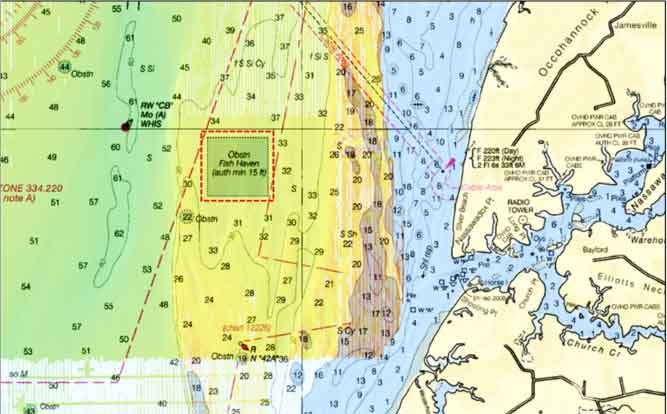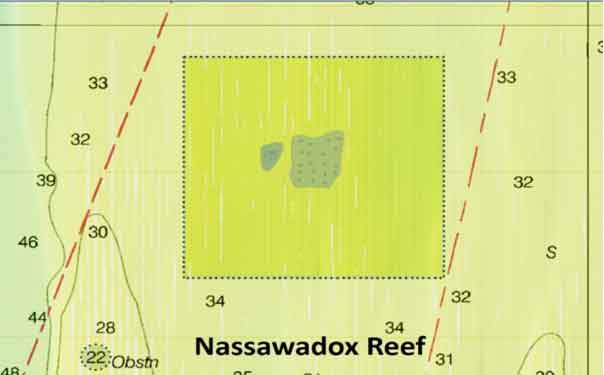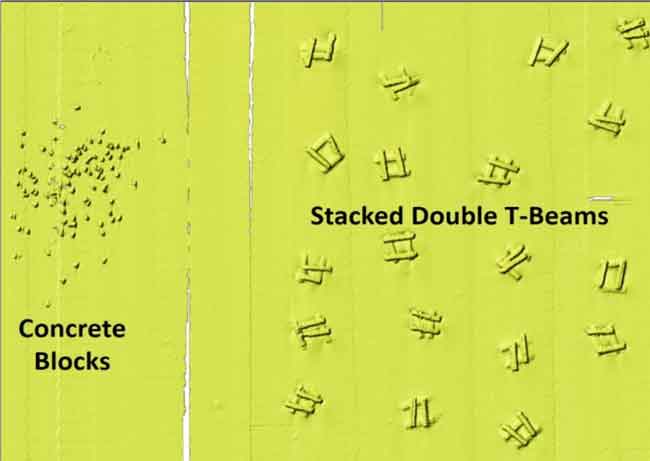Building marine structure with artificial reefs is an ongoing Coastal Conservation Association (CCA) initiative. Chapters in Virginia and Maryland have and continue to contribute to Bay restoration through fishing reef develop. Nassawadox Reef, for example, was supported by CCA’s Eastern Shore Chapter. Established in 2000, this fish haven provides hard structure with vertical height off the bottom in an area where natural structure and wrecks and obstructions with significant vertical relief are rare. Located about 2-1/2 miles northwest of the mouth of Nassawadox Creek, the fish haven is a modest run for light tackle anglers in this region of the Delmarva Peninsula.

The fish haven and bottom to the west and south are fully covered by National Oceanographic and Atmospheric Administration (NOAA) side-scan sonar. The images are accessible using NOAA’s interactive Bathymetric Data Viewer (BDV). A graphic derived from the BDV shows that, aside from some shallow troughs inside the reef boundary, the fish haven bottom is rather flat. On the north side, the bottom is also rather flat. To the south are some somewhat more pronounced troughs. Off to the west, there is an extended steep edge that drops off into a naturally deep-water channel running from Pocomoke Sound down along the Eastern Shore.
The layout of materials in this reef site is similar to some of the other reefs developed through the Virginia Marine Resources Commission (VMRC) artificial reef program. The initial structures here were constructed to a preplanned configuration rather than being randomly placed. Seventy-six double T-beams, each 60 feet long, were deployed. Two beams were placed in parallel to each other on the bottom, and two beams were placed across them. Nineteen clusters using this form were constructed and placed in a patch reef pattern around the center of the site. Seven years later, a thousand tons of concrete block were added. The blocks were more randomly placed using a patch reef pattern in the left-center of the fish haven. Coordinates for each of the T-beam reefs and the center point of the blocks reef are published in the Virginia Artificial Reef Guide produced by the Virginia Saltwater Sportfishing Association. The coordinates can also be extracted directly from the BDV (center coordinates are 37’29.58 x 76’00.95).

There is a very small obstruction in 29 feet of water just to the southwest of the fish haven’s southwest corner. The BDV shows a single, very small object. There’s also a long narrow ridge rising a few feet to about as much as 10 feet about a mile and a half to the east. The addition of the artificial reef structure provides a range of fishing opportunities. All the typical lower Bay species seasonally frequent the area.

Predators or schools of predators may relate to specific structures within the patch reefs or cruise among them looking for prey. So for jigging, fishing involves hunting and finding using your electronics to see where the sweet spot or spots may be. If sportfish such as striped bass or cobia are present, anchoring up-current and floating cut bait back to the reef in a chum line is an option.
For the more adventurous, a longer run to the southeast from Nassawadox Creek below Buoy 42 lies good flounder ground. Further south is The Cell, one of the more well-known of the Virginia artificial reefs. All of these locations are fine fishing destinations.
See our Chesapeake Bay Fishing Reefs Guide to get the lowdown on other mad-made wreck and reef hotspots in the Bay, plus a few in the ocean off the DelMarVa coast.
- By Wayne Young, author of “Bridges Under Troubled Waters: Upper Chesapeake and Tidal Potomac Fishing Reefs,” and "Chesapeake Bay Fishing Reefs: Voyages of Rediscovery," at Amazon.com. You can find his Facebook page at Chesapeake Bay Fishing Reefs.
Sign up here to get the weekly FishTalk Chesapeake Bay and Mid-Atlantic fishing reports in your email inbox, every Friday by noon.